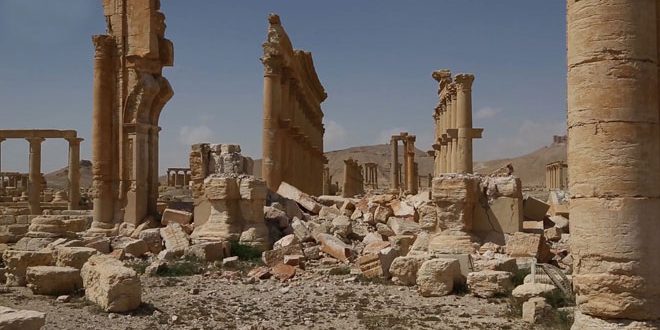PARIS- Despite the destruction of several iconic edifices, the archaeological site of Palmyra retains a large part of its integrity and authenticity, UNESCO’s experts said after their return from a technical rapid assessment mission to the historical Syrian city of Palmyra yesterday, noting that UNESCO will work with its partners to adopt emergency safeguarding measures, according to UNESCO Website.
The experts presented their preliminary findings regarding damages to the Syrian Arab Republic World Heritage site.
Headed by the Director of UNESCO’s World Heritage Centre, the mission, from 24 to 26 April inspected both Palmyra’s museum and archaeological site. The mission was escorted by United Nations security forces.
They took stock of considerable damage to the Museum where they found that most of those statues and sarcophagi that were too large to be removed for safekeeping were defaced, smashed, their heads severed, their fragments left lying on the ground.
The experts identified emergency measure to consolidate and secure the building and the considerable work that will be required to document, evacuate, safeguard and restore whatever is possible. Work to match and document the fragments of destroyed statues has already begun.
At the archaeological site, UNESCO’s experts took stock of the state of conservation of the grand colonnade and agora. They observed the destruction of the triumphal arch and Temple of Baal Shamin, which was smashed to smithereens.
 The participants had to examine damages to the Temple of Bel from a distance, as the edifice is still inaccessible and demining operations have not been completed. Likewise, the Mamluk Citadel, overlooking the ancient city, which also sustained serious damage, remains inaccessible.
The participants had to examine damages to the Temple of Bel from a distance, as the edifice is still inaccessible and demining operations have not been completed. Likewise, the Mamluk Citadel, overlooking the ancient city, which also sustained serious damage, remains inaccessible.
In the light of the mission’s preliminary findings, the Director-General of UNESCO, Irina Bokova reiterated the central place of heritage in the international community’s response to the crisis in Syria: “Palmyra is a pillar of Syrian identity, and a source of dignity for all Syrians. UNESCO is determined to ensure the safeguarding of this and other sites with all partners as part of broader humanitarian and peace building operations.”
The Director-General of Antiquities and Museums of Syria, Professor Mamoun Abdoulkarim, accompanied UNESCO’s experts and heads of several departments in charge of World Heritage museums, architecture and sites. The participants paid tribute to the courage of all those who work to document and safeguard the heritage of Syria, especially the Directorate-General of Syria’s Antiquities and Museums for its dedication to protect this heritage which belongs to all Syrians and to the whole of humanity.
A full report on the site will be presented to the World Heritage Committee at its 40th session, in Istanbul, Turkey, in July this year with a view to determining recommendations for emergency safeguarding measures that need to be taken. UNESCO will send an international mission of experts to examine in greater detail the state of conservation of heritage sites of Syria, including Palmyra. An international meeting of experts on the preservation of Syria’s heritage sites will be held on 2 and 4 June in Berlin, Germany.
The rapid assessment mission completed yesterday followed on the decision taken by the World Heritage Committee during its 39th session in Bonn, Germany, last July, and the decision unanimously adopted during the 199th session of UNESCO’s Executive Board concerning the Organization’s role in “safeguarding and preserving Palmyra and other Syrian World Heritage sites”.
The World Heritage site of Palmyra, an oasis in the Syrian Desert north-east of Damascus, contains the monumental ruins of a great city that was one of the most important cultural centers of the ancient world. From the 1st to the 2nd century, the art and architecture of Palmyra, standing at the crossroads of several civilizations, married Greco-Roman techniques with local traditions and Persian influences.
UNESCO

